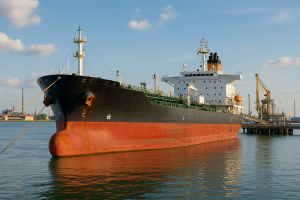Safe and efficient tanker operations require meticulous planning, regulatory compliance, and real-time coordination between ship and shore. This in-depth guide— consolidates essential procedures from ISGOTT, SOLAS, STCW, and detailed operator manuals to help deck officers, marine engineers, and maritime cadets prepare for crude oil and product tanker port calls.
This guide covers:
-
Pre-arrival terminal & mooring checks
-
Ship/shore communication protocols
-
Stability & trim planning before discharge
-
Discharge sequence coordination and contingency planning

1. Tanker Pre-Arrival Procedures: Terminal & Mooring Checks
Why Pre-Arrival Checks Are Critical
Before entering port, it is imperative to identify terminal restrictions, verify mooring arrangements, and account for environmental influences such as tides and currents. Failure to do so may result in hull damage, mooring failure, or marine pollution incidents.
1.1 Terminal & Berth Restrictions
Ensure safe berth compatibility by checking:
-
Permissible draft, air draft, and under-keel clearance (including tidal conditions)
-
Displacement tonnage and DWT limits
-
LOA and beam restrictions
-
Berthing side, mooring dolphin positions, and tug availability
-
Tidal windows and current limitations
-
Specific gravity of seawater at berth area for hydrostatic calculations
Reference: Operator’s berth info and Tanker Association manuals
1.2 Mooring & Tug Requirements
Conduct a comprehensive mooring plan review:
-
Number and type of mooring lines, bollard layout, and line strength
-
Tug assistance (number, type, and bollard pull requirements)
-
Emergency release procedures for adverse weather
-
Line arrangement diagrams considering parallel body length and manifold positioning
-
Shore-side radar or traffic separation zones
1.3 Shipboard Meetings & Safety Preparations
Hold a structured shipboard meeting to:
-
Review discharging, ballasting, and Crude Oil Washing (COW) plans
-
Align duties, simulate emergency scenarios
-
Discuss P/V valve setting, tank pressure conditions, and inert gas readiness
Best Practice:
Use checklists integrated into the vessel’s SMS. Pre-load crude oil washing and ballasting plans in compliance with MARPOL Annex I and ISGOTT.
🎥 Watch Video: Tanker Pre-Arrival Checks
2. Ship/Shore Communication Before Port Entry
Why Effective Communication Matters
Miscommunication is a leading factor in terminal delays, spill events, and equipment misalignment. A standardized communication framework is essential to operational integrity.
2.1 Mandatory Information Exchange
Prior to arrival, ensure the exchange of:
-
Cargo specifications (grade, temp, vapor pressure, quantity)
-
Manifold dimensions (flange size, connection height)
-
Details of defects in valves, IG systems, or instrumentation
-
Confirmation of available pumps and backup systems
2.2 Terminal-Specific Requirements
Review:
-
Crude Oil Washing (COW) requirements and approval
-
Flushing procedures for line changes
-
Tank gauging, ullaging procedures, and sampling
-
Restrictions on simultaneous operations (e.g., COW with de-ballasting)
ISGOTT Chapter 10 emphasizes the use of standardized checklists and communication forms.
2.3 Emergency & Safety Protocols
-
Emergency shutdown agreement (signal types, triggers)
-
Terminal regulations on vapor control and odor pollution
-
STS (Ship-to-Ship) procedures, if applicable
🎥 Watch Video: Ship/Shore Communication
3. Tanker Stability & Trim Before Discharge
Why Hydrostatic Balance is Crucial
Unbalanced trim or list can compromise hull integrity and mooring safety, particularly at Single Point Moorings (SPM) or during sequential discharges.
3.1 Calculating Hydrostatic Conditions
Use Class-approved stability software or onboard loading computers to:
-
Model longitudinal bending moments (BM) and shear forces (SF)
-
Maintain upright trim and correct heel
-
Plan ballast operations to control draft without exceeding terminal restrictions
3.2 Terminal & Operational Draft Limits
Incorporate:
-
Draft limitations at each port
-
Dynamic factors (tidal surge, weather, vessel motion)
-
Propeller immersion targets to retain maneuverability
Example: Aft draft > 10.5 m for 55% propeller immersion during ballast voyage.
3.3 Environmental & Operational Challenges
-
High winds increasing windage on the exposed hull
-
Liquid-sealed condition risks in ballast/cargo lines (require pressure relief)
-
Monitoring cargo/ballast tank pressures and P/V valve behavior
-
Anti-freezing measures for tank valves and IG equipment in cold climates
SOLAS Ch. XII mandates approved stability profiles be maintained at all times.
🎥 Watch Video: Stability & Trim Planning
4. Tanker Discharge Planning: Safe Sequence & Ship/Shore Agreement
Why a Discharge Sequence Must Be Agreed
Improper sequencing can cause:
-
Excessive hull stress from asymmetric unloading
-
Cargo contamination during line switching
-
Increased terminal time from miscommunication or unsafe conditions
4.1 Aligning with Terminal & Charterer Requirements
Validate:
-
Maximum flow rate and manifold pressure
-
Draft & trim at various discharge stages
-
Tank groupings for simultaneous discharge (avoid contamination)
-
Selection and staging of cargo pumps for optimal efficiency
Always confirm if the terminal accepts multiple grades simultaneously.
4.2 Multi-Port Discharge Considerations
Adjust plans to:
-
Prioritize tanks for early discharge
-
Control hydrostatic behavior through ballast shifts
-
Implement crude oil washing at intermediate ports only with prior approval
Recommendation: Estimate total discharge time at 70–75% of terminal’s max flow rate, excluding COW duration.
4.3 Crude Oil Washing (COW) Integration
Ensure:
-
Charterer/terminal approval
-
Pressure tests on COW lines at 110% working pressure
-
Inert gas pressure and oxygen levels (<8% vol) meet safety thresholds
-
Use of dry oil (not wet oil) for COW supply
-
COW sequencing does not delay final stripping
MARPOL requires adherence to the COW Operations Manual approved by class.
🎥 Watch Video: Discharge Sequence Planning
Conclusion: A Holistic Approach to Tanker Port Operations
To ensure safe and efficient tanker operations, always prioritize:
✅ Comprehensive pre-arrival planning
✅ Rigorous ship/shore communication
✅ Hydrostatic stability & ballast integrity
✅ A mutually agreed discharge sequence
✅ Compliance with ISGOTT, MARPOL, and SOLAS
Further References:
-
ISGOTT 6th Edition – Ship/Shore Safety Checklists
-
SOLAS Chapter XII – Tanker-specific structural requirements
-
MARPOL Annex I – Oil pollution prevention measures
Who Should Apply This Guide?
🧭 Deck Officers – Plan and execute port call strategies
🔧 Marine Engineers – Ensure system readiness and compliance
🎓 Maritime Cadets – Learn foundational tanker procedures
⚓ Terminal Operators – Coordinate with vessel for seamless operations
🚢 Stay Safe, Stay Compliant, and Smooth Sailing!


Thank youuuuuu
Informative, thx!
That`s great.
thank you